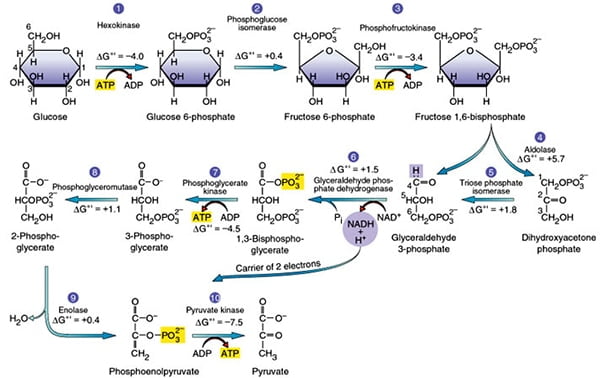Hi everyone! It has been a couple of weeks since I last posted because we have been so busy doing stuff in class! This week we worked on cellular respiration and its complicated steps. I’m going to post below all of the notes I took the other day in class.
Step Wise Energy Harvest Via NAD+ and the Electron
- NADH passes the electrons to the electron transport chain
- Unlike an uncontrolled reaction the electron transport chain passes electrons in a series of steps instead of one explosive reaction
- O2 pulls electrons down the chain in an energy yielding tumble
- The energy yielded is used to regenerate ATP
The stages of cellular respiration: a preview
- Glycolysis (breaks down glucose into two molecules of pyruvate)
- Pyruvate oxidation and the citric acid cycle (completes the breakdown of glucose)
- Oxidative phosphorylation (accounts for most of the ATP synthesis)
- Oxidative phosphorylation accounts for almost 90% of the ATP generated by cellular respiration
- A smaller amount of ATP is formed in glycolysis and the citric acid cycle by substrate-level phosphorylation
- For each molecule of glucose degraded to CO2 and water by respiration, the cell makes up to 32 molecules of ATP
Glycolysis harvests chemical energy by oxidizing glucose to pyruvate
- Glycolysis breaks down glucose into two molecules of pyruvate
- Glycolysis occurs in the cytoplasm and has two major phases
- Energy investment phase and energy payoff phase
- Glycolysis occurs whether or not O2 is present
- The citric acid cycle also called the Krebs cycle completes the breakdown of pyruvate to CO2
- The cycle oxidizes organic fuel derived from pyruvate, generating 1 ATP, 3 NADH and 1 FADH2 per turn
- The citric acid cycle has 8 steps, each catalyzed by a specific enzyme
- The acetyl group of acetyl CoA joins the cycle by combining with oxaloacetate, forming citrate
- The next 7 steps decompose the citrate back to oxaloacetate, making the process a cycle
- The NADH and FADh2 produced by the cycle relay electrons extracted from food to the electron transport chain
During oxidative phosphorylation, chemiosmosis couples electron transport to ATP synthesis
- Following glycolysis and the citric acid cycle NADH and FADH2 account for most of the energy extracted from food
- These two electron carriers donate electrons to the electron transport chain, which powers ATP synthesis via oxidative phosphorylation
The Pathway of Electron Transport
- The electron transport chain is in the inner membrane of the mitochondrion
- Most of the chains components are proteins which exist in multiprotein complexes
- The carriers alternate reduced and oxidized states as they accept and donate electrons
- Electrons drop in free energy as they go down the chain are finally passed to O2 forming H20
- Electrons are transferred from NADH or FADH2 to the electron transport chain
- Electrons are passed through a number of proteins including cytochromes
- The electron transport chain generates no ATP directly
- It breaks the large free energy drop from food to O2 into smaller steps that release energy in manageable amounts

What is your current level of understanding? These are great notes, but is there something you don’t understand or are you golden? It would also be helpful if you put this in a category and tagged it with a few key words!
LikeLike